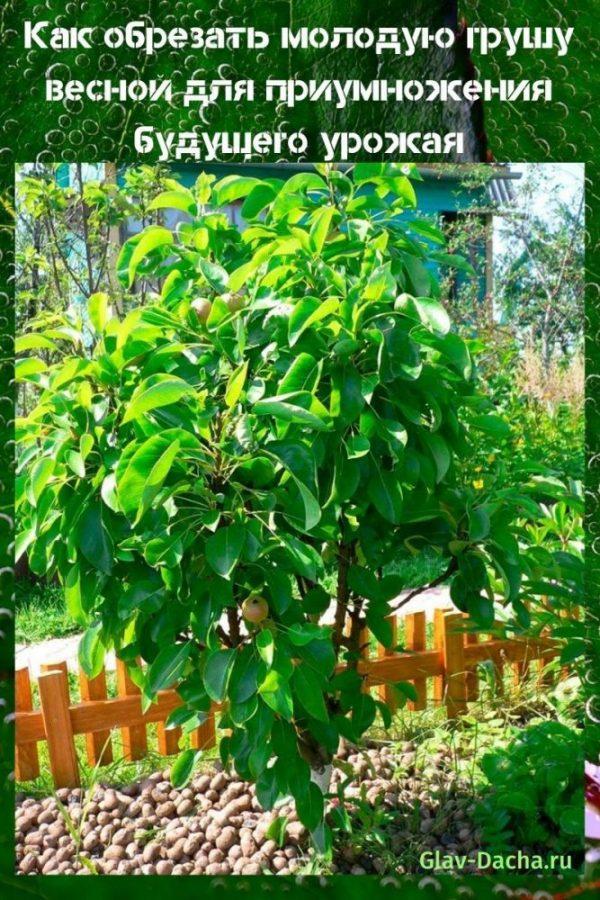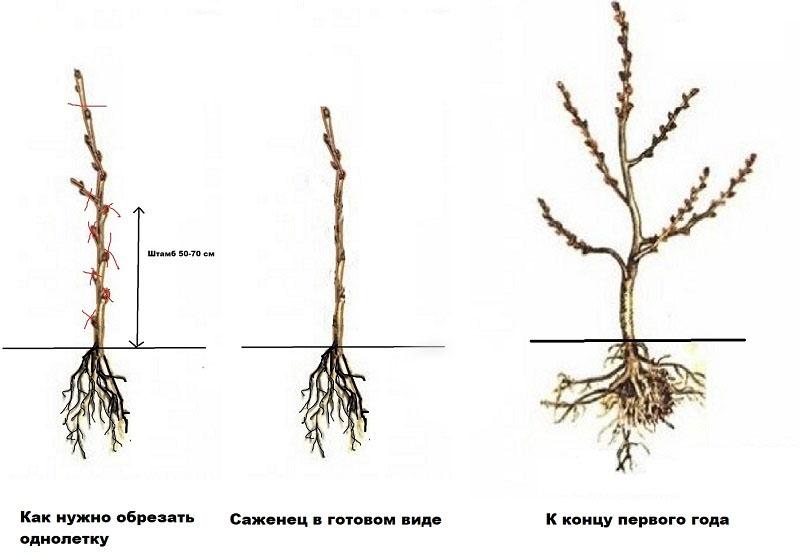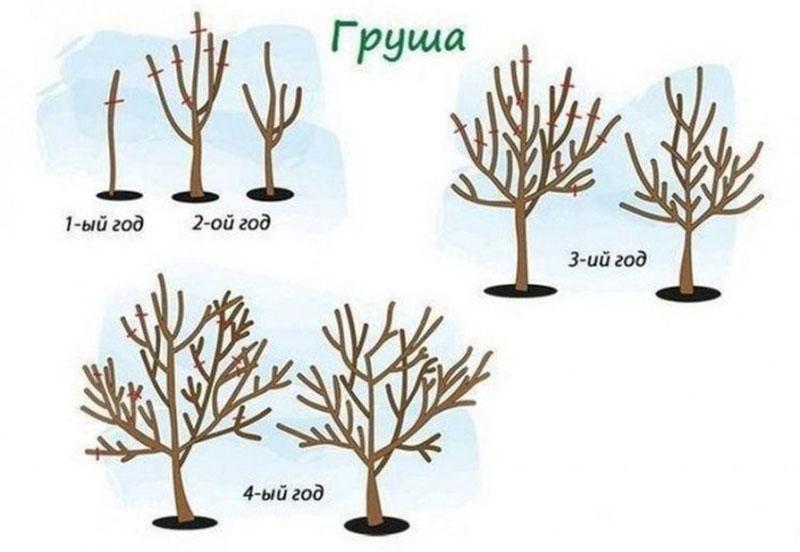How to prune a young pear in spring to increase the future harvest
 The basic rules for the formation of crowns of trees belonging to the category of pome crops are the same. To understand how to prune a young pear in spring, it is enough to know the general principles and take into account the biological characteristics of the genus.
The basic rules for the formation of crowns of trees belonging to the category of pome crops are the same. To understand how to prune a young pear in spring, it is enough to know the general principles and take into account the biological characteristics of the genus.
How to prune a young pear in the spring after planting

Such an increase does not form fruit twigs for a long time, therefore, pears that are not exposed to timely processing start bearing fruit late and are not able to realize the potential laid down by the breeders.
Pruning pears in spring after planting is the first in the life of a young tree, it is necessary in order to give the root system time to develop and recover. Until the underground part of the plant gets stronger, it is better to "slow down" the full development of the aboveground one.
The operation is performed immediately after the seedling takes its place on the site. How to form a pear after planting depends on its age, the degree of branching of the trunk:
- Trunks without lateral branches are cut 50–80 cm in height from the inoculation site.
- Well-formed seedlings require full processing. Lateral branches are cut to 0.3-0.5 lengths, the larger the shoot, the larger the size of the removed twig. The center conductor should protrude 20-25 cm above their level. In the process of performing the procedure, up to 5 kidneys can be removed on each process.
A well-formed seedling should result in a tree with 4 side shoots or less. They will become the basis of the future crown, skeletal branches of the first order. You can trim both the outer and inner kidney.
How to prune a pear if the branches are growing up
 Skeletal branches of the future pear should be formed at an angle no sharper than 60-65 degrees. If the shoot deviates too much from this value up or down, it is removed, leaving a shoot of 0.5 cm at the bud.
Skeletal branches of the future pear should be formed at an angle no sharper than 60-65 degrees. If the shoot deviates too much from this value up or down, it is removed, leaving a shoot of 0.5 cm at the bud.
Culture trees are prone to the formation of tops, vertically growing infertile shoots. Fighting them is difficult, but necessary to get a full harvest.
There are several main ways to handle such branches:
- Tenderloin is an effective method of fighting tops, but in spring it cannot be used to form pear crowns. By the fall, the tree will grow several of these shoots from one nest, which will only complicate the situation.
- Pinching barely visible growth during spring and summer prevents the formation of full-fledged tops, but requires constant attention to the tree, time.
- The cultivation of tops involves pruning them annually in such a way as to include the resulting shoots in the fruiting process.
"Taming" tops is the best way to form the crown of seedlings.
Pruning pears in spring for beginners will not be difficult if you use a convenient scheme for its implementation.
General principles of the formation of the crown of a young pear
 To cope with the task of spring processing of trees, it is important to clearly understand the end result of the effort expended.The crown, which must be obtained, belongs to the type of sparse-tiered, its shape must meet the standards for pyramidal.
To cope with the task of spring processing of trees, it is important to clearly understand the end result of the effort expended.The crown, which must be obtained, belongs to the type of sparse-tiered, its shape must meet the standards for pyramidal.
This means that the tree must be characterized by:
- the presence of a pronounced leadership part, a central conductor, and skeletal branches located in tiers;
- the correct ratio of the length of the shoots (the central conductor should remain the highest, the branches of each subsequent tier are shorter than the previous ones);
- the correct location of the shoots (the branches of each subsequent tier should not be parallel to the shoots of the previous row, otherwise they will shade them too much).
 As a result, by the middle age of the beginning of fruiting (5 years), a young pear, which was cut correctly in spring, is characterized by the presence of a stem 60–80 cm long, 2–4 branches of the first tier and 2–3 shoots of the second row. A space of about 50-60 cm remains between them, they themselves diverge in different directions, without interfering with the growth of each other.
As a result, by the middle age of the beginning of fruiting (5 years), a young pear, which was cut correctly in spring, is characterized by the presence of a stem 60–80 cm long, 2–4 branches of the first tier and 2–3 shoots of the second row. A space of about 50-60 cm remains between them, they themselves diverge in different directions, without interfering with the growth of each other.
There are other options for crown formation inherent in certain crop varieties:
- columnar trees need to create a fusiform crown;
- a tierless crown is suitable for vigorous varieties.
To obtain a compact tree, in spreading pear varieties, the cut is made on the inner bud. The branches of pyramidal-type trees are pruned to the outer bud.
The pear does not always respond to pruning the way a gardener would like. In some cases, this procedure needs to be supplemented with others, for example, bending of branches. Giving the shoots a horizontal position provokes the laying of a large number of flower buds, also performed in the spring.
When spring pruning is done
 It is important to carry out spring activities for processing the crown on time. The tree is sensitive to frost, therefore, a violation of technology can lead to loss of yield and even death of the seedling.
It is important to carry out spring activities for processing the crown on time. The tree is sensitive to frost, therefore, a violation of technology can lead to loss of yield and even death of the seedling.
The timing of pruning pears in spring is determined by the weather conditions of the region, the nature of the particular season. A time comes for safe processing when the severe frosts have already passed, but the tree itself has not yet "woken up". Usually this period falls on the end of March or beginning of April.
All tree pruning activities should be carried out before sap flow begins.
The main sign of the onset of crown processing time is the establishment of stable positive temperatures day and night. An increase in the length of daylight hours, warmth up to +5 ° C, increased soil and air humidity help the tree to recover from injuries faster, to put all its strength into laying buds and fruits.
How to properly prune a pear in spring

In order not to harm the tree, the gardener must follow the basic rules for processing the crown:
- All used in the process of work tools must be well sharpened, disinfected before starting.
- Slices, even small ones, must be processed with garden pitch.
- The strongest shoot requires constant support from the grower. In the spring, it is necessary to be especially careful to ensure that he has no "competitors" left.
- Sick, dry branches remaining after pruning a tree must be burned in order to avoid the spread of infectious plant pathologies.
- Too much pruning of pears causes increased topping. To prevent this from happening, do not get too carried away with the procedure. The processing of neglected trees is carried out in several stages.
 It is necessary to strictly observe the terms, the technology of spring processing, so as not to destroy the plant. So, when trimming on the cambial ring, the shoot is cut off clearly along its line from the outside. Large branches are removed in two passes, starting from the bottom, and ending from above, so as not to break off the bark.
It is necessary to strictly observe the terms, the technology of spring processing, so as not to destroy the plant. So, when trimming on the cambial ring, the shoot is cut off clearly along its line from the outside. Large branches are removed in two passes, starting from the bottom, and ending from above, so as not to break off the bark.
In the spring, a young pear is pruned like a tree preparing for active fruiting and not needing rejuvenation. Old crops are handled somewhat differently.
There are several basic types of processing the crown of young seedlings, the choice of the right one is determined by the tasks that the gardener faces:
- Sanitary pruning involves removing dead, old branches.
- Thinning pruning is designed to lighten the crown, improve air exchange inside it. The procedure consists in removing some of the shoots that intersect with each other, and those whose growth is directed inward to the aerial branched part of the tree.
- Stimulating pruning requires up to a third of the length of the shoots to be removed. It is necessary to limit their growth in the vertical direction, to cause enhanced lateral branching.
- Formative pruning of young pears in spring according to the scheme is the basis for growing young trees. A strong skeleton and a strong crown, obtained as a result, are able to withstand the most heavy snowfalls, an impressive mass of ripe fruits.
 Each new year of the life of a seedling carries difficult tasks for the gardener. The first four seasons, when the crown is formed, are decisive. In the future, it will only need to be kept "in good shape", preventing it from thickening, overgrowing with barren shoots, and clogging up with dead branches.
Each new year of the life of a seedling carries difficult tasks for the gardener. The first four seasons, when the crown is formed, are decisive. In the future, it will only need to be kept "in good shape", preventing it from thickening, overgrowing with barren shoots, and clogging up with dead branches.